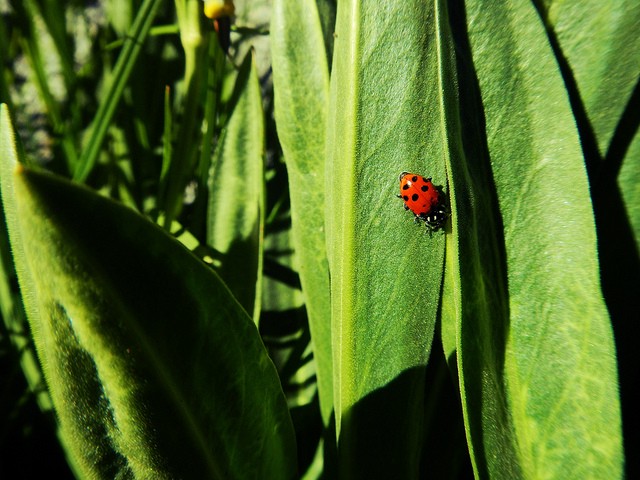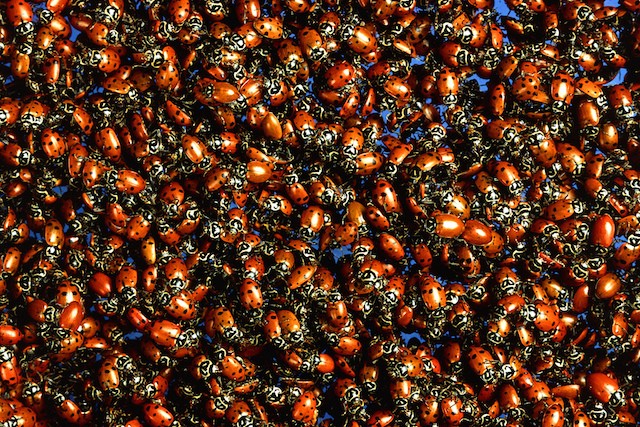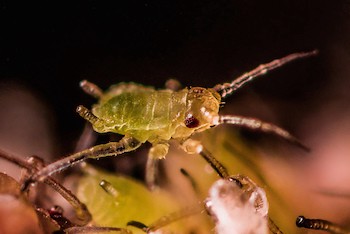The Flight of the Ladybugs
by Cat Ferguson

Every winter, ladybugs coat trees and hillsides in the Sierra Nevada mountains with bright orange scales. Each aggregation can contain millions of the insects, hunkered down in a kind of seasonal dormancy called diapause, and every year, collectors head out with snow shovels, nets, and bags to scoop them up by the millions. The beetles are sold to wholesalers, who offload the haul to farmers and gardeners as a living insecticide. This year, though, Arbico and Natural Pest Controls, two major wholesale suppliers of ladybugs, ran into a problem: there weren’t enough ladybugs to collect.
Both companies blame California’s severe drought and ongoing wildfires. According to one of Arbico’s sustainable agriculture specialists, Arianna Weisbly, wildfires have ravaged the ladybugs’ spring feeding grounds, while hot weather and drought have prevented them from entering diapause. “Global warming and human input (I’d wager most of the wildfires are human caused) have basically halted our collection,” she wrote in an email. But there’s another, less studied possibility: that unabated mass collection has thinned the Sierra Nevada population of convergent lady beetles. “No one ever looked to see if collecting hundreds of millions of lady beetles from the Sierras each year was sustainable,” Scott Black, executive director of the Xerces Society, a non-profit dedicated to invertebrate conservation, told me. In fact, no one is studying the population at all, so it’s impossible to tell how many ladybugs are gone — or why.
The Lost Ladybug Project, a citizen science program that tracks ladybug populations around the country, has noted for years that populations of many lady beetle species have been shrinking or moving around — the result of an unknown number of variables. For instance, between ten and fifteen percent of wild ladybugs carry deadly parasites, which may spread when animals are relocated for agricultural use or otherwise change locations. Some species also face competition from the Asian lady beetle, which was originally imported to control soybean aphids; it not only outcompetes the locals for food, it carries a deadly fungus.
According to Leslie Allee of the Lost Ladybug Project, losses of ladybug populations have the potential to increase the use of chemical pesticides, since even non-organic farms rely on the spotted bugs to keep pest populations down. “Ladybugs are part of complex food webs,” Allee wrote in an email. “A reduction in ladybug numbers could result in a surge of aphids and other soft bodied insects, and this, in turn, could affect other parts of the web and result in reductions in plant health or plant survival in certain areas.”

Each ladybug species has a specific feeding preference, but generally they eat aphids, tiny green dots that decimate food crops and ornamental plants. “Aphids will go after just about anything they can get their little mouths on,” Brian Morris, the head of horticulture for the Central Park Conservancy, which buys and releases ladybugs into the park every summer, told me. That includes roses, corn, peas, cotton, potatoes, and cabbage. On top of their versatile appetites, aphids breed fast, and in large numbers. “Aphid are born pregnant. They’re like Russian dolls,” Morris said. Other animals eat aphids, including lacewings, wasps, and praying mantises, but lady beetles, as ladybugs are technically known, are a favorite among farmers and gardeners because they’re cheap, ravenous and charismatic. From the moment they hatch, they prey on aphids with a voraciousness hardly suggested by our screensavers and desktop backgrounds. “If you’re an aphid, that’s the scariest predator in town,” John Trumble, an entomologist at UC Riverside, told me.

So, instead of using chemical pesticides, many farmers and gardeners have come to rely on convergent lady beetles as a “natural” solution. (The most common agriculture pesticides deployed against aphids are organophosphates, which are acutely toxic to humans and implicated in colony collapse disorder in bees. The chemicals are nerve agents, dispatching animals of all sizes in brutal, twitching deaths.) One farmer in Washington state, who asked not to be identified, released two gallons of ladybugs across a hundred acres of peas in July — around twelve hundred ladybugs per acre. “I like the thought of using them from the standpoint of less chemicals, less harm to pollinators and other beneficial insects,” he said.
Unfortunately, there’s a century of evidence that moving ladybugs around the country isn’t as effective as conventional pesticides at suppressing aphid populations. On waking from their winter slumber, the ladybugs are naturally inclined to have a snack and then fly off to warmer digs within a few days. “There’s tons of information that these are collected when they’re in the mountains, and when they wake up from hibernation they’re predisposed to fly. Basically, you release them in your yard and they fly three, ten, forty miles, and they’re in somebody else’s yard doing pest control,” Black said. He suggests growing plants that will naturally attract ladybugs, instead of importing them.
Farmers who do release ladybugs will probably lose around ninety percent of their flying workforce within a week. A 1919 California State Commission of Horticulture bulletin noted: “After three days, fewer and fewer beetles could be recovered, and at the end of a week hardly a beetle was visible even if abundant food was present. Moreover, counts made in other parts of the field indicated that but a small percentage, rarely estimated as over 10 per cent, had remained in and dispersed themselves over the field.” The Washington farmer reported similar results in 2014. “I do not believe a lot of them stayed,” he said. “The aphid population we had was incredible. They should have had plenty to feed on,” the farmer said. He said he’d be happy to try again next year, though, with even more ladybugs.
Some gardeners recommend spraying the ladybugs with a sugar solution, to glue their wings shut, to keep them around for longer. But rather than forcing adults to stay, Morris thinks it’s a better idea to rely on the ladybugs’ offspring. “It’s not so much the adults we release that control the aphids. It’s primarily their progeny, the larvae that hatch the following year, that really do the job,” Morris said of the Central Park releases. “They look nothing like ladybugs — they’re a little scary looking.” A female can lay up to five hundred eggs, and each baby eats around fifty aphids a day. Morris believes that ladybugs lay eggs before decamping, though scientists have not confirmed this.
Assuming there are enough ladybugs left to capture, the practice will probably continue. “You can buy ladybugs that have been grown in a nursery, but it’s much more expensive” and not very common, Trumble said. It’s much easier to just scoop up wild beetles while they’re in diapause, regardless of the consequences. “If the population starts to bounce back, are collectors going to get right back out there to collect them?” Black asked. “I think we should curb this practice until we know what the overall impacts are.”
Cat Ferguson is writer with a dog and an email address.
Photos by Oliveoligarchy, USDA, and scyrene, respectively
